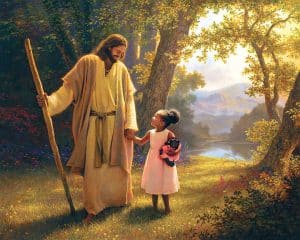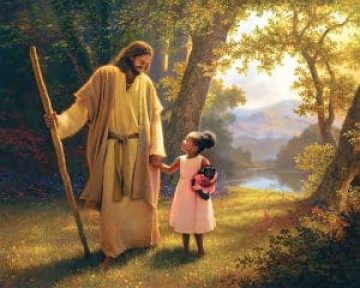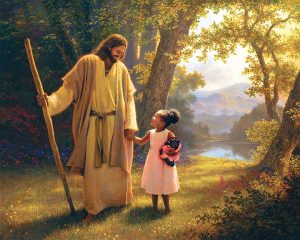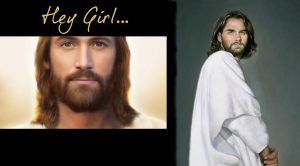I’m a sucker for Christmas music. The religious stuff. The schmaltzy stuff. The weird stuff the Latin major turned ward choir director plays that no one recognizes. I’m old enough that I remember the Firestone records they gave away at gas stations, lovely combos of songs and artists; mix tapes before mix tapes. I embrace it all and cycle through favorites. As a kid I adored the Chipmunks (“Me? I want a hula-hoop!”) but thankfully my tastes have progressed a bit. A few years ago I could not get enough of “The Cherry Tree Carol” and I never tire of “Do You Hear What I Hear?” Any version. Last year I stumbled upon a song I’d never heard before and it reduced me to a yuletide puddle. I’m including a link to the version by Kenny Rogers & Allison Krause instead of the one by James Taylor. (I know this seems heretical, but trust me, the Gambler wins hands down. I also know that some of you are rocking in a corner because I’m promoting Christmas music too early. Sorry.)
Some Children See Him
by Alfed Burt & Wihla Hutson
Some children see him
Lily white
The baby Jesus
Born this night
Some children see him
Lily white
With tresses soft
And fair
Some children see him
Bronzed and brown
The Lord of heav’n
To Earth come down
Some children see him
Bronzed and brown
With dark
And heavy hair
Some children see him
Almond-eyed
This savior whom
We kneel beside
Some children see him
Almond-eyed
With skin
Of yellow hue
Some children see him
Dark as they
Sweet mary’s son
To whom we pray
Some children see him
Dark as they
And, ah
They love him, too
The children
In each diff’rent place
Will see
The baby Jesus’ face
Like theirs
But bright
With heav’nly grace
And filled
With holy light
O lay aside
Each earthly thing
And with thy heart
As offering
Come worship now
The infant king
‘Tis love
That’s born tonight
Let me try to explain why this song speaks to me so strongly. Last year I joined a group of women researchers who went to Botswana to collect Mormon women’s oral histories. On our first Sunday we attended a ward in Gaborone and I was floored by this picture that greets you as you enter the building. I had never seen a black person featured so prominently in Church art and it seemed so appropriate in that ward of African saints. I felt proud.
After church several of us traveled out to a more rural ward in Molepolole to do interviews. There was no art on the dirty cinderblock walls but there was a room filled with women waiting to share their stories. One of the questions we ask is about how people imagine the characteristics of divinity, as in do you see God as warm and loving, kind yet remote, etc. I asked this of the shy sister who spoke so quietly about a childhood of poverty and years of abuse. She got really excited and looked me in the eyes for the first time. She leaned in close and said, “How do I picture God?” I nodded. “I KNOW God is black!” and slowly traced her finger down her beautiful cheek. Then she leaned back, smiled sheepishly while hugging her sleeping toddler and added, “No offense.”
As I shared that story with my fellow researchers on the long ride back, it occurred to me that of course her God is black. The Lord speaks to each in her own tongue. Not even Americans are arrogant enough to think that God only speaks English. And surely within a language, the vernacular and style of communication reflect the one seeking solace. So why had it taken me decades to see that my imagining Jesus as a blue eyed blond European was a reflection of my own biases just as much as a result of being surrounded by art the reinforced that? God made us in their image, isn’t it then natural for us to make God in ours? (My art historian friend claims that Mormons favor “Salon Jesus,” a well built god with luxuriant locks and piercing eyes, like a Ryan Gosling meme.)
The next week when I entered the ward in Gaborone, I was again surprised by the painting of white Jesus and with the black girl. What had felt radical the week before now felt paternalistic, well meant but off the mark. In subsequent interviews I asked about conceptions of God and Christ, and tried to get the women to share their ideas on the physical and racial representations of deity. But none of my other interviewees volunteered anything and it felt wrong to push, as if I had a racial agenda.
This last June I again went to Africa to do more interviews. This time in Johannesburg. When I pursued my inquiries there, the responses were almost identical among the dozen or so sisters: God is beyond racial, neither black nor white, but a being that somehow transcends color. I also asked about the Savior. To a person they all said, “He’s not white or black. He’s Jewish.” It seemed to be a diplomatic way of turning the Lord’s race into a no man’s land, as they see Jewishness as its own special category. If neither of us could claim him as our tribe then we have equal access.
Yet I keep coming back to wondering, does how we picture deity affect the way we worship? I know that as a woman, when I expand my spiritual yearnings to include a Heavenly Mother, I find a special kind of comfort. After my first trip I consciously altered the images in my head of deity. How would my prayers be different if I imagined God as an African? If the Savior were Hispanic? If Heavenly Mother were Asian (you’re picturing Chieko, I know it)? My kids tease me when I say things like “God bless” and “thank the Lord.” “So is that black Jesus you’re thanking?” And I laugh because I know I’ve gotten a bit locked on to the racial representation of the divine. I know my imagining God as Morgan Freeman as opposed to Charlton Heston is hardly radical. But I think I’ve been enlarged by the trying.
So as I make myself a new Christmas playlist for the season, “Some Children See Him” is at the top of my queue. I will play it when I get out my nativity sets and have my white, black, and brown Holy Families displayed side by side. And I hope that the little Christian kids around the world will imagine a manger scene that allows them to see themselves in the Christ child. And my dearest Christmas wish is that one day the art on the walls of our churches will reflect the diversity of the people who worship therein.
Honestly, I haven’t a clue what God looks like. But I KNOW I am loved. And for now, that’s enough.







18 Responses
Perfect! I love seeing nativities from other cultures, another way to reimagine divinity. Also, “Corde Natus Ex Parentis” (Latin minor, many years ago).
Love!! I miss you!!
I had never heard that song before!! How perfect to remind us that our Savior is so much more than we imagine, but still is ours. I think it would benefit us to have pictures of Him in our meetinghouses, temples and homes in a variety of hues. It would remind us that we are all one family and no one person/ color is any better than another. (And thanks for the link. (Love Allison Kraus and well, Kenny Rogers has a white beard– it’s real and not a glue-on one…)
I was sitting on a train once in Washington DC. At one point in my trip a black man with grey hair got on, and sat a few seats in front of me. As I looked up at him a feeling of shock came over me, I recognized him — he looked like Heavenly Father to me. It sounds totally crazy, I know, but it was the most amazing flood of recognition. I *knew* that that face is what God looks like. I had never actually thought about what He must look like, to be honest, though I knew Him so intimately in my heart! And there he was sitting a few seat in front of me, probably totally bewildered as to why I was staring at him (hope I didn’t creep him out!). I totally picture deity as black.
My light hearted telling of that experience doesn’t do it proper justice. It remains one of the most spiritual experiences I’ve had. I have often wondered if I worried that poor man, though. I couldn’t stop staring at him.
This story is so tender and touching. Have you written it down? If you ever do, it would make a great guest post for us! Thank you
I’ll consider that! Thanks, Heather!
I love this post. I sang ‘Some Children See Him’ with my high school choir and I’ve thought a great deal through my many years about what Heavenly Father and Mother may look like. I loved the book ‘The Color of Water’ which title quotes what a Jewish mother says to her mixed race, black-skinned child when he realizes there are two colors of skin in his family and asks, “What color is God?” I think I am prepared for any color. I want to be. Thank you for reminding me of one of my favorite songs and for my appreciation and love of God!
The main reason I have collected so many nativities over these many years has been the opportunity to see how so many people and cultures see Jesus and His family. What’s also interesting is how different the wise men’s gifts are treated in each of these–in some nativities they bring Zopfbrot (Swiss) in others it is flowers or bananas. To Heather’s point, the Crèches show how Christ speaks to the carver, the builder, the sewer. But they also show what gifts are important enough to each culture to offer the Christ child.
http://www.midwaychristmas.com/
Some 200+ creches on display! It’s lovely and a fun activity for the family. Free.
I was raised on the outskirts of an inner-city neighborhood and attended an inner-city high school. Some of my best friends from then and to this day are black. And the images they had of Jesus were black. And I saw my black Jehovah’s witness friend walk miles and miles on Sundays to teach people about God, yet be rejected, but got us and did the same thing again and again– I saw the love of Christ, without colour, without preference– yet entirely of love.
Each of us sees and feel Jesus in our own way. Nuthin’ wrong with that.
Thank you for the lovely post (one of my faviourite nativities is one my husband brought me home from Chile– all are wearing traditional Chilean [colourful!] manger-style clothes and all have dark skin. I love it with all my heart!)
As a child I asked a bishop if we would all be white in heaven. He reassured me that every color was perfect, forever. But all the women of color in my family have married men several shades whiter. I am now in a place in life where I can only imagine a black Jesus. But for most of my life I’ve imagined Jesus, salvation and heaven in shades of white. Thank you for helping me to reflect on my own perceptions and how I came to see and believe as I do.
I’ve always loved that carol, although I admit to preferring James Taylor’s version to that of Kenny Rogers even with the divine voice of Alison Krauss. Several of the alfred burt.Wihla Hutson carols are beautiful. My favorite is a Simon and Garfunkel version (off one of those “mix-tapes” CDs of Christmas gifts, while not given anyway free by Firestone, still sold very cheaply) of “The Star Carol.”
I will go find it immediately. Thank you!!
Love, love, love this, Heather.
The beautiful words to the song made me cry!
I was recently at the Washington DC temple visitors center and they had a room filled with nativity scene displays from all over the world. Each was beautiful and displayed the holy family in the way of each culture. I also went into the temple to do the sacred work there. As I entered I stopped at the mural of Christ at the judgment separating the righteous from the wicked. Among the righteous are people from all races cultures and times. It really doesn’t mater to me if Jesus is black or white or green. All people are invited to come to Him, and that is good enough for me.
[…] #LightTheWorld this Christmas by doing unto others as you would have done unto you. Honor their e… […]